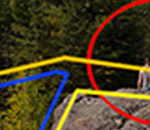
This attention to detail undoubtedly brings wonder and is certainly worth taking a little time for a closer look. Indeed when this attention is applied to even the most commonplace of nature subjects there is clearly an extraordinary display of beauty and orderliness to be found. These combine to create patterns in nature that require only an observant and discerning eye to behold. This vision instils a lasting appreciation of the simplicity and beauty of the natural world and with this understanding and harmony there is everlasting enjoyment.
The natural world in all its glory has a myriad of examples for us to photograph but we can start with the common things that we tend to overlook. Simply because of their familiarity they offer the very best opportunity for observation. Here we can find patterns in nature that can be circular, linear and random or indeed a combination of all three. Sometimes they are obvious and sometimes they require a little effort and imagination to search out. Nature is full of patterns that interact and play off of each other that are well worth seeing. They offer a different view on our world, that if we are honest, with our ever-increasing hectic lifestyle we often take for granted. With a discerning eye for detail, pattern and colour we can look at any natural object as simply a series of shapes composed of lines, curves and circles. Then consider ways in which these shapes and patterns relate with one another. Often it is this interaction that provides such a rich and diverse array of patterns that can satisfy even the most inquisitive amongst us and provide the opportunity for unique photo subjects.

A similar pattern can also be found in a single rose. The rose has long been recognised as an emblem of simplicity and one of our most loved and beautiful flowers. The pattern emerges as the petals radiate spirally outwards from the centre and one is almost drawn into its glorious depths. With this power it is little wonder it is the flower of love.
Very often natural objects contain patterns within patterns that are only revealed by looking further and further into the subject. Indeed, nature is very generous and only too pleased to welcome us in to see all her glory. You can be assured that she will allow the very closest of inspections and will not disappoint.
With this renewed awareness a simple nature photography walk takes on new meaning. Just recently whilst walking on the beach I was attracted to the patterns of sand left behind as the water retreated down the beach with each wave. The patterns that were created suggest energy and motion reflecting both the fluidity and continuity of the ebbing tide. This happens twice a day and has been doing so for countless years in the natural world but it is interesting that almost identical patterns can be found after each tide. I find this repetition intriguing as it shows a consistency throughout the ages. However, even though the patterns in nature may reoccur, the colours and reflections change dramatically with the changing light, time of day and weather conditions. So even a visit to the same place will always provide something new and fresh to contemplate and challenge the mind.

There are also many patterns within the world’s fauna; a giraffe or zebra for example clearly exhibit very striking patterns. In these examples they are patterns with a purpose namely for camouflage and defence. Closer to home, however, a simple feather can show wonderful linear patterns with the shaft, barb and barbules and their interlocking hooks combining together to provide both strength and flexibility. In particular the feathers of the much-maligned magpie have an iridescent sheen and offer wonderful colours to enhance the strong diagonal pattern.
So, with renewed vision and childlike wonder the natural world is without doubt a beautiful place that only requires time and an inquisitive mind to fully appreciate. With all the negatives that abound it is reassuring to know that satisfaction and contentment can be provided by the most simple of things.
Redstart Photography
Redstart photography by Phil McDermott based on the Isle of Mull in the west of Scotland specialising in nature and environmental photography. http://www.redstartphotography.com
Like This Article?
Don't Miss The Next One!
Join over 100,000 photographers of all experience levels who receive our free photography tips and articles to stay current:






Leave a Reply